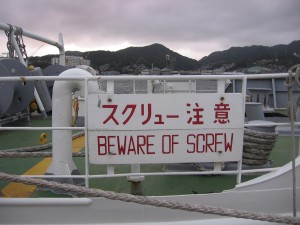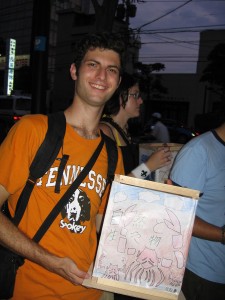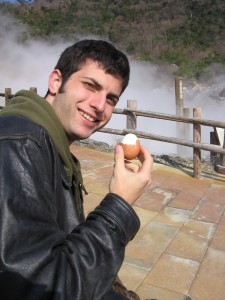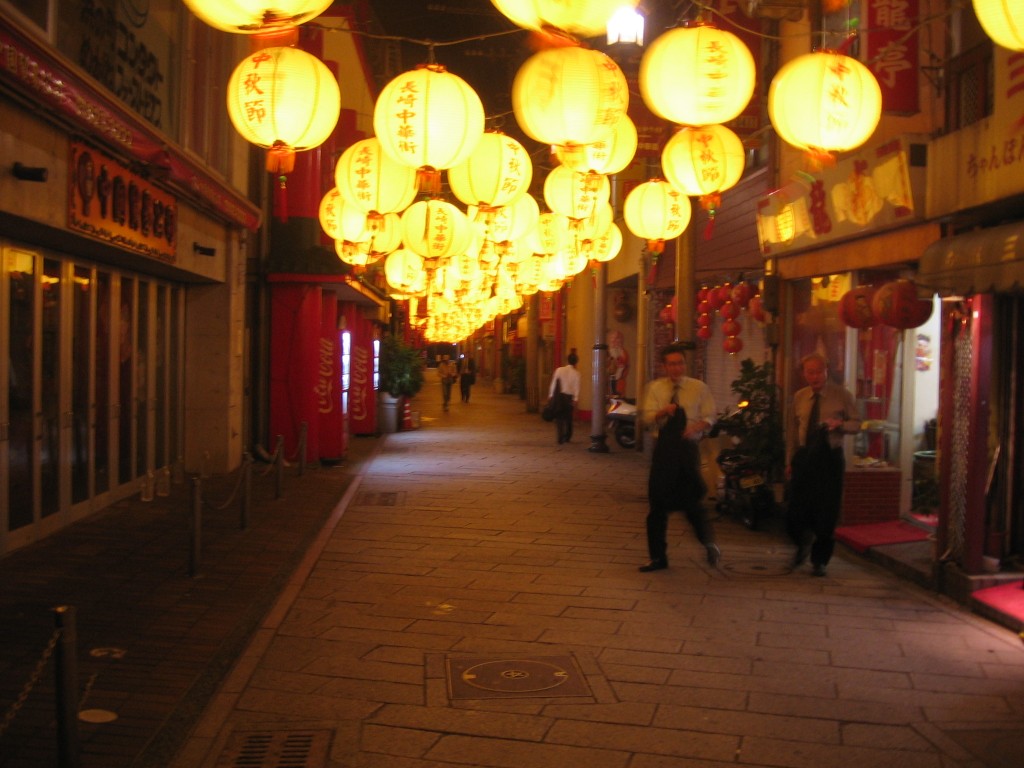
No, I didn’t get into funny mistranslations, or Japan’s bizarre sexual culture. I hope this sign suffices for both.
Author’s Note: When I set out to write this piece, I didn’t think it would take so long to fully convey my complex feelings about Nagasaki. As such, it has become a series within a series, originally released in two parts, but you can read the whole text here. If you’ve missed my previous posts in the “Strange Places I’ve Called Home” series, please check out my posts on Milwaukee, South Florida, and Knoxville.
Of all the strange places I’ve lived, Japan might have been the strangest, and keep in mind, I’ve lived at a fake castle approximately two miles from the North Korean border. It was also at one of the strangest times of my life. I was a fresh college grad, expected to teach children, but I was still learning how to be an adult.
There was a time in my life when I was not so cavalier about packing up, leaving my whole life behind, and starting all over again on a new continent. There’s a first time for everything, and my first time living abroad happened to be in a small village on the outskirts of Nagasaki, Japan.
Although I had been dead-set on joining the JET (Japanese Exchange Teaching) Program for nearly a year prior to my departure. A great deal of my energy was committed to being accepted into the program, and not to the consequences of that decision. Mostly, I occupied myself with the task of finishing university on a high note, working at Waldenbooks, and waiting to hear back from the Japanese Consulate in Atlanta. It took me months to gather all of the necessary materials (in triplicate, of course) and mail off a thick envelope, containing more pages than most crime novels. Then I waited for a few months, until I got a short email asking me to interview in person in Atlanta. I drove about 8 hours that day; the interview lasted less than 20 minutes. A few more months hence, I received another short email, this one congratulating me for making the 2006-07 JET Program waiting list. Did this mean I was accepted? Perhaps. When could I find out? They couldn’t tell me, and I was instructed not to call and ask.
After another two months of waiting, and with my apartment lease winding down, I had all but given up hopes of landing a spot in that year’s contingent of JET teachers. Instead, I had landed an interview for another job, this time in Chengdu, China. The Fates had other plans, and a wicked sense of humor, so naturally the day of the interview, I received a call from the Japanese Consulate in Atlanta, asking if I was still interested in working in Japan. After all of the time and effort, how could I possibly say no? From that day forward, I had less than six weeks to pack up and say goodbye to my life in Knoxville, Tennessee. The time passed in a blur, and I didn’t even know where I was going to end up yet. I could have been anywhere from tropical Okinawa to frigid Hokkaido.
With less than three weeks before my departure, I learned that Nagasaki–a city whose name is forever tarnished by that horrible day in August of 1945–would be my home. Before I knew it, I was saying tearful goodbyes, first to my girlfriend (who shortly thereafter became an ex), and then my Mom, who dropped me off in a new suit at a ritzy hotel by the airport, where the new class of JETs were meeting prior to departure. We were thrown into the deep end. Most of us were recent college graduates, almost all younger than 30, and mostly younger than 25. After checking in, we walked around the air conditioned lobby, in our new suits, socializing and acting like we were older than we were. The official “Orientation” was short, and unmemorable. The night went by quickly, and before I knew it, I was several glasses of whisky into deep conversations with people I would never see again after that night.
The next morning, we all went our separate ways, despite our shared common destination of Tokyo, for yet another, more thorough, three-day JET Orientation. Some of us flew through Minneapolis, some through Detroit, or Toronto, or New York. I flew through Chicago O’Hare. I can’t even imagine the logistics of setting this up every single year. All the same, I was happy to be flying through Chicago. It was here that my first ever trip abroad started, and as we departed, we flew directly over Milwaukee, allowing me one last ceremonial “Good-bye” to anywhere that could remotely be considered my home.
Several times throughout the day, I had these exact words travel through my brain, “What the FUCK am I doing?” Once was on the way to the airport in the hotel shuttle. Another was after boarding the plane. And finally again when our plane left U.S. airspace just off the coast of Alaska. It reminded me of the time I went bungee jumping–I hadn’t been frightened until I started leaning forward on my jump and thought, “Perhaps this isn’t the best idea,” but then, as in now, it was too late to turn back.
This all brings us to Nagasaki. The city should be famous for any number of reasons, but all of those are overshadowed by a single bomb which effectively ended World War II. The city should have been known for its centuries-long tradition of international trade with China and Holland, even when the rest of Japan eschewed the outside world. Or for being the proud owner of the oldest stone archway bridge in Japan. Or for the Lantern Festival, or the local specialty noodle dish champon, or any other number of things. But instead, it’s known for its dubious distinction of being one of two cities devastated by an atomic bomb.
That day is never far from public consciousness, and my introduction to life in Nagasaki was greatly shaped by “Peace Day,” the annual commemoration of the bombing on August 9th. For one, it was the day I was introduced to my school as the new English teacher. We had just watched a two hour animated movie about the bombing of Hiroshima as told through the eyes of a child, and then I was asked to stand up in front of everyone and say (in what will undoubtedly go down as the worst Japanese in the history of the World) “Hi, I’m Zachary Marx, your new English teacher. I’m from America. Nice to meet you.” There are moments when speaking publically that you hope for a raucous laugh from the audience. This was not one of those moments, but laugh they did. It was quite the shock introduction, and in retrospect, probably the first clue that I might have not been the right fit for the job or Japan in general.
It is difficult for me to reflect on my time in Japan with any sort of clear, unbiased perspective. I don’t know if I was too young, or too immature to fully appreciate my new environment, or if Japan was truly a bad fit for me. Regardless, when I was living there, I was the proverbial fish out of water every single day.
After two consecutive summers in China, I thought I would have been more prepared for life in the Far East. If anything, my previous experience actually made adjusting to life in Nagasaki more difficult. Japan is a land of countless unspoken rules, and holding yourself to a certain standard. In China, chaos reigns supreme, and manners aren’t really a thing. As such, I never really felt comfortable or settled in Japan. I always felt like I was committing a cultural faux pas (because I almost certainly was), and I just didn’t see the big deal about eating and walking at the same time, or wearing scented deodorant, or a million other things that I did without thinking about it, but which offended the locals.
To make matters worse, I didn’t ingratiate myself to my colleagues at all. I thought I knew what was expected of me from the various orientations and a year of researching the JET Program, but when I arrived, all of that was thrown out the window. The stated goals and expectations of the Program often conflicted with the stated goals and expectations of the local school boards, and by the time I figured that out, it was already too late. Also, I was replacing a teacher who had been there for three years, spoke fluent Japanese, and was loved by her school (though apparently not any of the other expats). These were big shoes to fill, and I failed miserably.
I learned, unfortunately when it was far too late to do anything about it, that my difficulties with colleagues were not just minor differences in philosophies or culture, but were major problems from their perspective. Perhaps if I had been more culturally attuned to the Japanese work dynamic, I could have seen some warning signs, or solved some of these problems with one-on-one discussions with my coworkers, but instead the issues were passed up the chain of command, and I heard about it all from the head of the English Department at the Nagasaki Board of Education on an unseasonably nice day in February. It was an incredible shock, and instead of having a discussion about the best way to go forward with my colleagues, I was being read a prepared list of wrongs by the head honcho. It was far from productive, since I was still never given any clear direction other than, “Don’t do these things I just listed.”
I’m not going to play the victim here–there was a great deal more I could have done–but given the ample preparation time I had, I would have been more than happy to prepare lesson plans if I had known from my coworkers what we were doing ahead of time. Some of the complaints were legitimate, but others like the aforementioned deodorant issue were just simple cultural differences that had been blown up into major problems. Granted, the Japanese are not known for being so culturally open minded, certainly not with their own citizens, and there was never a foreigner exception for me either.
With eight years’ perspective between going to Japan and now, I see my failures in a slightly different light. There are things I would do differently now, sure, but this wisdom has only come about as a result of my failures during that year and since. Although it may sound clichéd, failures are only failures if we do not learn from the mistakes and change our approach going forward. Problems with fitting into work and society aside, I still look back at Nagasaki with a sense of wonder, because it is so different to any other place I’ve lived or even visited.
Many places have pest problems, but nothing could have prepared me for the sight of literally thousands of small crabs living around my apartment complex. I’ll never forget the first couple of meetings I had with the small arthropods. It started on the very first morning I had in my new home. The crabs weren’t even my first shock that morning. I had had the windows open since my air conditioning had only two settings–mildly cool and not working–and Nagasaki is hot and humid in early August. I rose out of bed to find hundreds of students streaming past my window heading to school, and there I was, standing like some sexual predator in only my underwear. I quickly shut the curtains, hoping that none of my future students saw me.
As I left the apartment to catch the bus into the city, I heard the noise of scurrying animals into the small bushes surrounding the complex. The sound was unlike any I had ever heard before, like a chipmunk, only heavier, denser. I briefly looked around the area from where the noise originated, but saw nothing. I abandoned my search, and quickly attributed the noise to the active imagination of a sleep and caffeine deprived brain. When I finally returned from the day-long orientation (yes, another orientation) in the city (complete with getting lost several times, more on that in a bit), I heard that strange noise again. This time, awake, alert, and properly caffeinated, I explored further. When I followed the noise around the corner behind my apartment, I saw them. The crabs were scurrying around in the hundreds, perhaps thousands. There was no more denying that I was in a foreign land, and I quickly fled up the stairs and shut my door tightly.
That shock soon wore off, and I slowly began to see these crabs as friendly bystanders to my Japanese adventure. Though terrifying at first, I soon realized that they would clear a path around me as I walked the trails around my little village. And when they went away for winter, I even grew to miss them.
The crabs should have been a good indication, but I would have never guessed that I was so close to the ocean. On an island nation, you never expect to be far from the sea, but even by Japanese standards, my five minute walk to the water’s edge was exceptionally close. I loved walking down to the ocean, and watching the waves roll in, but I was never once tempted to jump in. The beach was surrounded by large, concrete blocks, allegedly there to prevent erosion. They might have been effective at that, but they were far more effective at keeping me out of the water.
Again, shortly after my arrival, I found myself facing another natural phenomenon that I had never had to worry about before: typhoons. Throughout my year, we dealt with several typhoons of varying degrees of concern, but the biggest by far happened about one month into my stay. Somehow, I wound up hosting a typhoon party with about eight other English teachers. I’ve never quite experienced anything like this storm before or since. The water level in the tiny little stream that flowed past my apartment rose several meters, as the water started flowing in from the storm surge. The wind was literally pushing the water to flow uphill. Soon thereafter, the electricity went out, and we had to sit and wait in candlelight as our ears popped from the low pressure. Suddenly, the violent wind stopped, and we were treated to clear skies above us. The eye of the storm passed silently around us. It was a direct hit. Within an hour, the wind picked up again from the other direction, though not as fierce this time around. We awoke the next morning, to find several trees and poles broken or bent, as well as a few windows blown out, but the rest of the village was largely unscathed. While it is a complaint of many, there is a reason why a great deal of Japan is made from re-enforced concrete.
The crabs made it through unscathed.
Here, I must take a moment to give credit to the Japanese people for surviving so long on islands that clearly want to kill them. Japan regularly suffers typhoons, earthquakes, volcanoes, tsunamis, and the occasional Godzilla attack. When I boiled eggs in one of Mt. Unzen’s numerous hydrothermal vents, it was a unique experience, but I didn’t have to look too far back in history to find this mountain’s deadly past: 43 dead from a 1993 eruption, and 15,000 dead from a late 18th century Unzen-inspired mega-tsunami. Getting out of Japan by only experiencing a moderate typhoon and some hard-boiled eggs seems like a pretty good deal after the fact.
Natural disasters aside, another common complaint about Japan is that its cities seem to all fall victim to the same boring, block apartment design flaws, leading to a bland, uninspired skyline, making it all but impossible to differentiate between cities. This cannot be said about Nagasaki. The city rises majestically out of a long, beautiful harbor, and rises precipitously up two valleys, split by a dramatic mountain range. Of course, there were a great deal of boring, block apartments, but the impressive scenery, coupled with its well-preserved (or in most cases, well-reconstructed) historical sites, has given Nagasaki some much-needed flavor to complement its efficient Japanese style. This led to a great deal of exploration throughout the city; there were few things I enjoyed more than strolling around the back alleys, or walking through the newly constructed Seaside Park, or along the harbor, and taking in the views. I have especially fond memories of sharing a few beers with friends in Seaside Park, one of the few spots in the city with real grass. The park jutted out into Nagasaki Harbor, giving us a 360-degree panorama of the city.
Many American tourists leave Japan in awe of their high-prices, but I can’t say I had the same feelings. Granted, I was also living away from Tokyo, in a relatively small city. It also helps that I was earning Yen, not coming over with my pockets stuffed with dollars. And, add to the fact that I paid practically no rent, made more money than I ever had before—or even more than I knew what to do with—I didn’t consider it too expensive. All the same, I did notice a few peculiarities about Japan’s money situation. For one, it was expensive if you wanted to buy what can only reflexively be referred to as “Western food.”
Also, it was almost entirely a cash-based society. This fact is not all that odd. What was odd was the fact that the ATMs had opening hours, so trips to the bar had to involve a bit of financial planning, especially if you wanted to take a taxi home after the evening’s festivities. This fact seems to have had the longest lasting impact on my day-to-day life. I would start off each month by withdrawing the amount of money I thought I needed from an ATM, and then leave the rest in the bank. I’ve never been the best at balancing my checkbook (hey! remember when that was a thing?), so I liked the fact that I could see and feel my money, and know that it had to last me until the next paycheck. It’s a habit that I still use today.
It seems so quaint to mention, but I must talk briefly about: “My First Time Living Without a Car,” or, “Nagasaki City Public Transportation: Horrible, or Worst in the World?” If there’s one area Americans are spoiled, it’s in car ownership. Only major cities in the U.S. have anything close to approaching serviceable public transportation, and in smaller towns and greater suburbia, having a car is as necessary as milk is to your morning cereal. If you don’t like your morning cereal with milk, or if you’re an American living in suburbia living without a car, you’re weird, and I don’t want to deal with you. So, while I had been on subways and buses in other parts of the world, I had never had to deal with it as part of my daily grind. Despite all of my subsequent travels, in Japan and abroad, I’ve never had the displeasure of discovering a worse, more confusing, less foreigner-friendly transport system than Nagasaki’s.
My life, more or less, revolved around the #7, and #30 buses. In most cities a bus number signifies a certain route; you take the #7 bus north into the city, and the #7 bus south to come back. Nagasaki laughs at your foolish notion about numbers and bus routes and decided to make their system as complex as possible. While I did take the #7 bus north (and thankfully there was only one), there was no #7 bus that went south, and certainly not one that would take me the same route back home. Instead, I had to take the #30 bus south, but there were over a dozen #30 buses, all heading south, all going to disparate parts of the city. I had to check the kanji—the Chinese characters—which accompanied the #30 on the front, which wasn’t so easy for a fresh-off-the-boat gaijin, who had admittedly limited experience taking buses to begin with.
My first trip to the city nearly ended in disaster. Our orientation had finished, and I managed to find my way back to the bus stop that would take me home. Each passing #30 bus gave me a great sense of anxiety, as I checked and rechecked the kanji against the written note my Japanese coworker had given me. As the long procession of #30 buses rolled by, I grew more and more nervous about being able to find my way home that night. Finally, there was a bus with kanji that looked kind of like what she had written, if I squinted in just the right way and held the paper at an angle, so I got on. It was the wrong bus, but it wasn’t a complete disaster. Luckily, it was the only other #30 bus that would even take me within walking distance of my apartment.
Like so many other difficulties of living in a new country, with a new language, taking the bus became easier. And it was on the #7 bus into the city one October day that became one of the most important moments of the year. As we approached the city, we were treated to a beautiful sunset over Nagasaki harbor. I looked up from my book, and saw the red-orange disk burning a hole in the sky, reflected and refracted a million different ways by the still water. The sun setting over the Land of the Rising Sun. But the brilliant sunset wasn’t the important thing. It was, however, enough to kick me out of my normal routine into a Zen-like moment of conscious self-reflection. Living abroad had started out as this amazing adventure, but now it was just simply “living.” Although I was still having new experiences every day, I was also living my life, going to work, taking the bus, paying bills, doing laundry, and countless other “normal” daily routines. This culture shock was unlike any I’ve experienced since, because it was the moment I realized that my life abroad had become completely normal, albeit far from ordinary.
In the end, I can’t say I ever thrived in Japan. I spent a great deal of time isolated and lonely at work and at home. Work was a true struggle, one in which I never adequately overcame the communication and cultural barriers. Outside of school, I met some great friends, and had a great time exploring Japan. I didn’t thrive, and I wouldn’t be anxious to give it another go there, but I did survive, which was the most important lesson.
Thanks for reading. The next segment in this series will cover my year in the second biggest metropolis in the world, Seoul, Korea.





